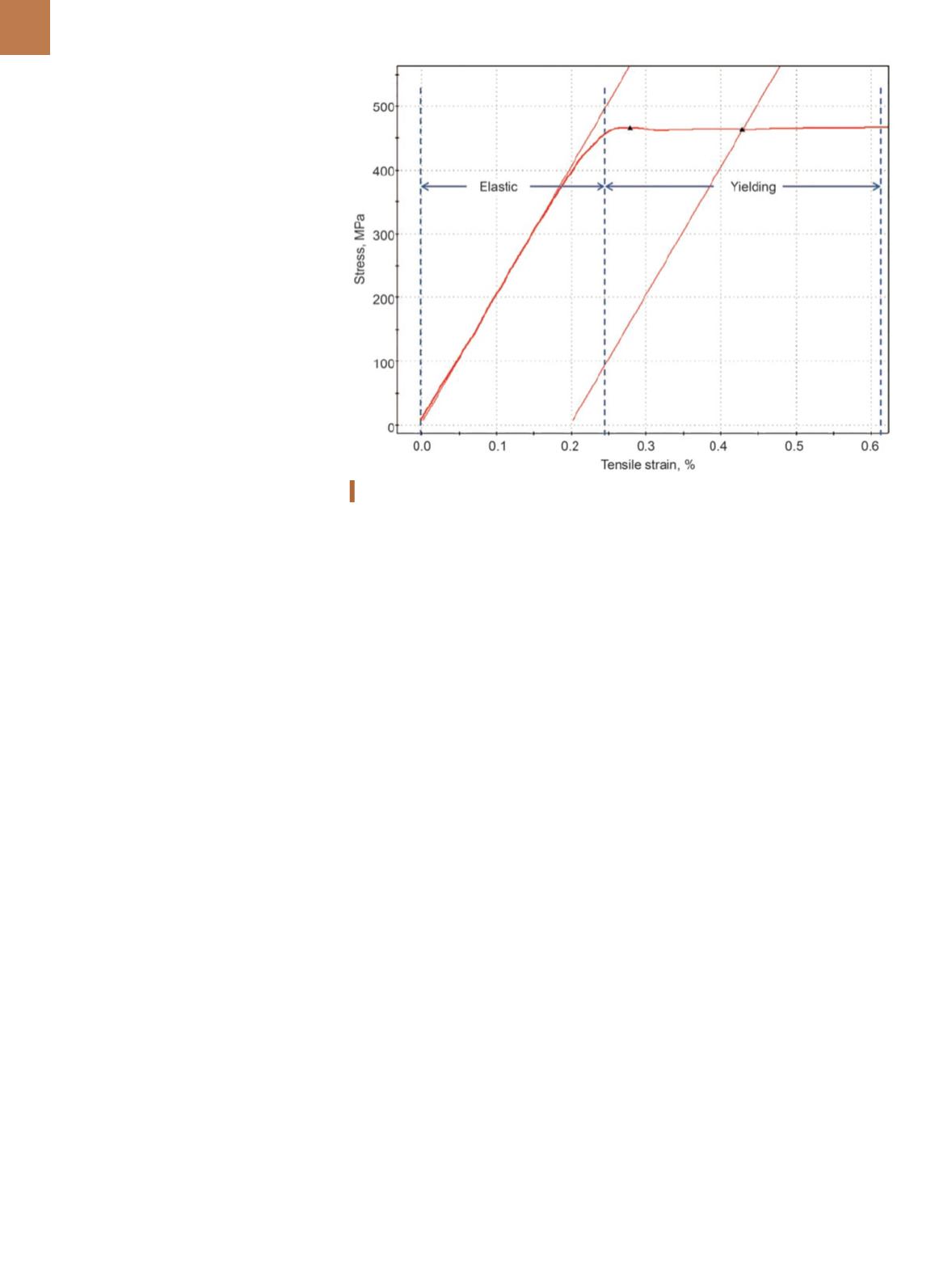

A D V A N C E D M A T E R I A L S & P R O C E S S E S | J U N E 2 0 1 5
2 6
(<5% of expected yield strength) to the
specimen in order to properly seat it in
the grips and to also aid in pulling the
specimen straight prior to testing. A
plot of stress or force versus crosshead
or actuator displacement will typical-
ly show significant displacement for
a minimal increase in load due to the
grips and load string pulling tight (tak-
ing up system compliance). If a preload
is not applied and an extensometer is
being used, many rebar specimens will
show negative strain at the beginning
of the test as the specimen straight-
ens. Because of this and/or system
compliance, data obtained during the
preloading portion of the test is often
ignored or not recorded on the
stress-
strain
graph.
On servo-controlled systems, pre-
loading is usually done slowly using
crosshead or actuator displacement
feedback for controlling the test speed.
Controlling preloading from load, stress,
or strain feedback is not recommend-
ed as it could lead to undesirable and
rapid acceleration until the specimen is
pulled tight in the grips.
Depending on the amount of sys-
tem compliance or slack that was taken
up during the preload, it may be nec-
essary or desirable to zero the strain
measurement at the end of preloading.
However, caution must be taken to not
adversely affect overall strain measure-
ment. In either case, test results that
rely on strain from the extensometer
should be adjusted so any nonlinear
behavior at the very beginning of the
test curve does not adversely affect test
results.
Elastic region (before yielding):
The
elastic region or straight line portion of
the test as seen on the stress-strain plot
often exhibits some initial nonlinear
behavior due to further straightening
of the rebar specimen. If using an ex-
tensometer, this may appear as slightly
negative strain at the beginning of the
test and is generally considered normal
for rebar. Depending on the standard
being followed, a variety of test control
and target speeds are allowed during
the elastic region and until the onset
of yielding. The control and associated
rate used may depend on equipment
limitations or the specific product be-
ing tested.
When running tests on servo-
controlled systems, it is important to
keep the following scenarios in mind.
If using crosshead or actuator displace-
ment control, it is generally acceptable
to use the same control and speed
through both the elastic and yielding
portions of the test. However, if stress
or strain feedback control is used, the
test must switch to crosshead or actu-
ator displacement control just before or
at the onset of yielding.
Yielding:
Once yielding begins,
many rebar grades exhibit a defined
yield point that appears as an abrupt
bend in the stress-strain test curve. It
is then followed by a period of spec-
imen elongation with little to no in-
crease in force. Because of this, servo-
controlled systems must be regulated
using crosshead or actuator displace-
ment feedback to maintain a constant
rate of travel throughout yielding. It is
important to note that using stress con-
trol during yielding will cause the test to
accelerate excessively, which is in direct
violation of the standards. This can also
cause the yield point (upper yield) to be
masked or smoothed and cause yield
strength results to be higher than ex-
pected. Likewise, strain control from an
extensometer can also become erratic
during yielding and is not recommend-
ed when testing rebar.
Plastic region after yielding:
As
standards clearly define, it is accept-
able to increase test speed after yield-
ing is complete. For servo-controlled
machines, the best way to control the
test during this final region is from
crosshead or actuator displacement
feedback (same as yielding). However,
speed can be increased according to
the standard being followed. This al-
lows the test to be completed in a short-
er period of time while still producing
acceptable and repeatable results.
A NOTE ON NOMENCLATURE
Test standards incorporate terms,
result names, and symbols to proper-
ly identify critical information sought
during testing. It is important to fully
understand this information in order
to ensure standards compliance and
proper results reporting. If testing to
multiple standards, it is also neces-
sary to understand the similarities and
Elastic and yielding regions of a rebar stress-strain curve.


















